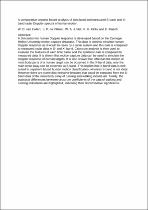 ResearchSpace
ResearchSpace
A comparative cepstral based analysis of simulated and measured S-band and X-band radar Doppler spectra of human motion
JavaScript is disabled for your browser. Some features of this site may not work without it.
- ResearchSpace
- →
- Research Publications/Outputs
- →
- Conference Publications
- →
- View Item
| dc.contributor.author |
Van Eeden, WD

|
|
| dc.contributor.author |
De Villiers, JP

|
|
| dc.contributor.author |
Nel, Willem AJ

|
|
| dc.contributor.author |
Kloke, KH

|
|
| dc.contributor.author |
Blasch, E

|
|
| dc.date.accessioned | 2018-02-12T09:55:10Z | |
| dc.date.available | 2018-02-12T09:55:10Z | |
| dc.date.issued | 2015-10 | |
| dc.identifier.citation | Van Eeden, WD, De Villiers, JP, Nel, WAJ, Kloke, KH and Blasch, E. 2015. A comparative cepstral based analysis of simulated and measured S-band and X-band radar Doppler spectra of human motion. 2015 IEEE Radar Conference, Sandton Convention Centre, 27-30 October 2015, Johannesburg, South Africa | en_US |
| dc.identifier.uri | http://www.radarconf15.org/Papers/viewpapers.asp?papernum=5062 | |
| dc.identifier.uri | http://hdl.handle.net/10204/10035 | |
| dc.description | Copyright: 2015 IEEE. Due to copyright restrictions, the attached PDF file only contains the abstract of the full text item. For access to the full text item, kindly consult the publisher's website. | en_US |
| dc.description.abstract | A simulation for human Doppler response is developed based on the Carnegie Mellon University motion capture database. This data is used to simulate human Doppler response as it would be seen by a radar system and this data is compared to measured radar data in S- and X- band. Cepstrum analysis is then used to evaluate the features of each time frame and the synthetic data is compared to measured data. It is shown that motion capture data can be used to simulate the Doppler response of human targets. It is also shown that, whereas the motion of most body parts of a human target can be observed in the X-band data, only the main torso sway can be observed at S-band. This implies that X-band data is well suited to cepstrum based human motion classification, whereas S-band is not ideal. However there are some discriminative features that could be extracted from the S-band data of the main body sway of running and walking individuals. Finally, the statistical differences between cepstrum coefficients of the data of walking and running individuals are highlighted, indicating their discriminative significance. | en_US |
| dc.language.iso | en | en_US |
| dc.publisher | IEEE | en_US |
| dc.relation.ispartofseries | Worklist;16103 | |
| dc.subject | Radar | en_US |
| dc.subject | Human Doppler responses | en_US |
| dc.subject | Cepstrum analysis | en_US |
| dc.title | A comparative cepstral based analysis of simulated and measured S-band and X-band radar Doppler spectra of human motion | en_US |
| dc.type | Conference Presentation | en_US |
| dc.identifier.apacitation | Van Eeden, W., De Villiers, J., Nel, W., Kloke, K., & Blasch, E. (2015). A comparative cepstral based analysis of simulated and measured S-band and X-band radar Doppler spectra of human motion. IEEE. http://hdl.handle.net/10204/10035 | en_ZA |
| dc.identifier.chicagocitation | Van Eeden, WD, JP De Villiers, WAJ Nel, KH Kloke, and E Blasch. "A comparative cepstral based analysis of simulated and measured S-band and X-band radar Doppler spectra of human motion." (2015): http://hdl.handle.net/10204/10035 | en_ZA |
| dc.identifier.vancouvercitation | Van Eeden W, De Villiers J, Nel W, Kloke K, Blasch E, A comparative cepstral based analysis of simulated and measured S-band and X-band radar Doppler spectra of human motion; IEEE; 2015. http://hdl.handle.net/10204/10035 . | en_ZA |
| dc.identifier.ris | TY - Conference Presentation AU - Van Eeden, WD AU - De Villiers, JP AU - Nel, WAJ AU - Kloke, KH AU - Blasch, E AB - A simulation for human Doppler response is developed based on the Carnegie Mellon University motion capture database. This data is used to simulate human Doppler response as it would be seen by a radar system and this data is compared to measured radar data in S- and X- band. Cepstrum analysis is then used to evaluate the features of each time frame and the synthetic data is compared to measured data. It is shown that motion capture data can be used to simulate the Doppler response of human targets. It is also shown that, whereas the motion of most body parts of a human target can be observed in the X-band data, only the main torso sway can be observed at S-band. This implies that X-band data is well suited to cepstrum based human motion classification, whereas S-band is not ideal. However there are some discriminative features that could be extracted from the S-band data of the main body sway of running and walking individuals. Finally, the statistical differences between cepstrum coefficients of the data of walking and running individuals are highlighted, indicating their discriminative significance. DA - 2015-10 DB - ResearchSpace DP - CSIR KW - Radar KW - Human Doppler responses KW - Cepstrum analysis LK - https://researchspace.csir.co.za PY - 2015 T1 - A comparative cepstral based analysis of simulated and measured S-band and X-band radar Doppler spectra of human motion TI - A comparative cepstral based analysis of simulated and measured S-band and X-band radar Doppler spectra of human motion UR - http://hdl.handle.net/10204/10035 ER - | en_ZA |





